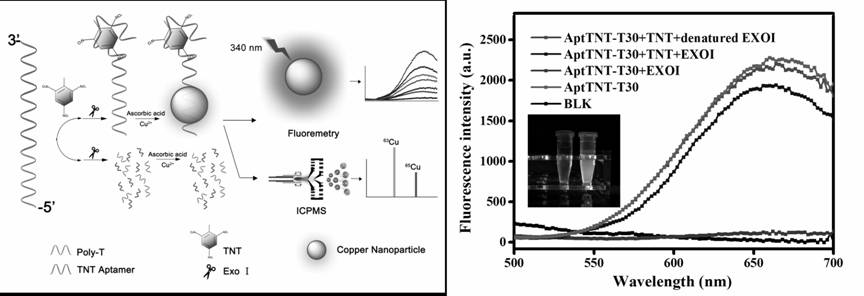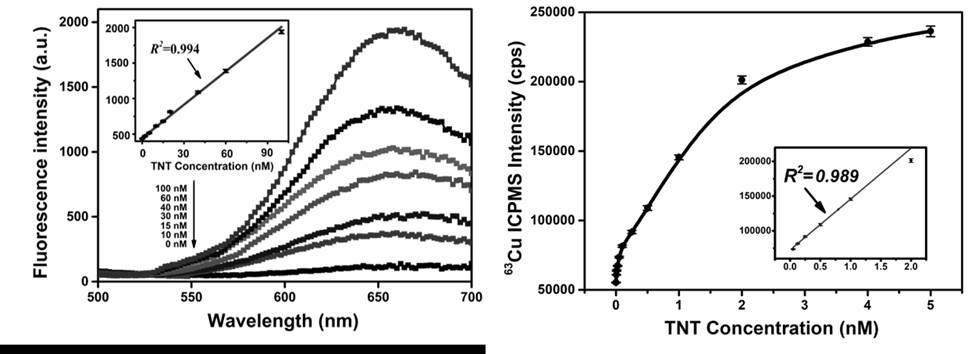A "fluorescence-stable isotope" dual-mode detection method for p-trinitrotoluene
A stable isotope, trinitrotoluene technology, used in fluorescence/phosphorescence, material excitation analysis, etc., can solve the problems of difficult long-term stable and accurate quantitative analysis, limited photobleaching effect and matrix effect, etc., to achieve high-sensitivity detection. , long-term stability and high sensitivity detection, the effect of small matrix effect
- Summary
- Abstract
- Description
- Claims
- Application Information
AI Technical Summary
Problems solved by technology
Method used
Image
Examples
Embodiment 1
[0058] Embodiment 1, whether to form the comparative experiment of terminal group protection to TNT detection
[0059] In order to confirm that the formation of end group protection at the end of TNT and AptTNT-T30 aptamer is the key to the synthesis of PolyT CuNPs, the AptTNT-T30 probe was used as an example to respond to TNT, and compared the formation of end group protection with or without the presence of ExoⅠ enzyme on the synthesis of PolyT CuNPs. Effect of Fluorescent Properties of Poly-CuNPs. In the experiment, add TNT sample 200nM, ExoI 40U, excitation wavelength 340nm, emission wavelength 660nm. Depend on figure 1 It can be seen that when there is no TNT sample, no end group protection is formed. After adding ExoⅠ enzyme, the digestion reaction with AptTNT-T30 occurs, and the fluorescence signal response is significantly weakened, which is close to blank, and PolyT CuNPs cannot be formed. However, adding inactivated ExoⅠ When the enzyme was used, the fluorescence r...
Embodiment 2
[0060] Embodiment 2, exploring the specificity detection of TNT by the analytical method of the present invention
[0061] This example uses the "fluorescence-stable isotope" dual-mode p-trinitrotoluene detection method to detect various interfering substances (other common explosives, metal ions, amino acids and biological enzymes), and explores the analysis method of the present invention Specific detection ability for TNT.
[0062] 1. Detection of TNT and other interfering substances
[0063] Using the specific steps above, TNT and various interfering substances were detected in the fluorescence detection mode and the stable isotope detection mode, respectively.
[0064] Among them, in the fluorescence detection mode, first react 10 μL, 10 μM AptTNT-T30 substrate and 10 μL test substance in a PCR instrument. Among them, the concentration of TNT to be tested is 20nM, other interfering substances are 1mM, and the reaction conditions are 25°C, 90min. Then add 25 μL Nebuffer...
Embodiment 3
[0068] Embodiment 3, exploring the sensitivity detection of the analytical method of the present invention to TNT
[0069] This example explores the sensitivity and linearity of TNT detection in the fluorescence detection mode and stable isotope detection mode.
[0070] 1. The sensitivity detection of analytical method of the present invention to TNT
[0071] In the fluorescence detection mode, first react 10 μL, 10 μM AptTNT-T30 substrate and 10 μL TNT of different concentrations in a PCR instrument. Among them, the concentration of TNT to be tested is 20nM, other interfering substances are 1mM, and the reaction conditions are 25°C, 90min. Then add 25 μL Nebuffer 3 buffer solution and 40U Exo I for enzymatic hydrolysis reaction. The PCR reaction conditions were 37° C., 120 min. After the enzymatic hydrolysis reaction, the temperature was raised to 85°C for 15 minutes to inactivate the enzyme. Finally, 10 μL of 20 mM ascorbic acid solution and 35 mL of 1 mM copper sulfate ...
PUM
 Login to View More
Login to View More Abstract
Description
Claims
Application Information
 Login to View More
Login to View More - R&D
- Intellectual Property
- Life Sciences
- Materials
- Tech Scout
- Unparalleled Data Quality
- Higher Quality Content
- 60% Fewer Hallucinations
Browse by: Latest US Patents, China's latest patents, Technical Efficacy Thesaurus, Application Domain, Technology Topic, Popular Technical Reports.
© 2025 PatSnap. All rights reserved.Legal|Privacy policy|Modern Slavery Act Transparency Statement|Sitemap|About US| Contact US: help@patsnap.com



